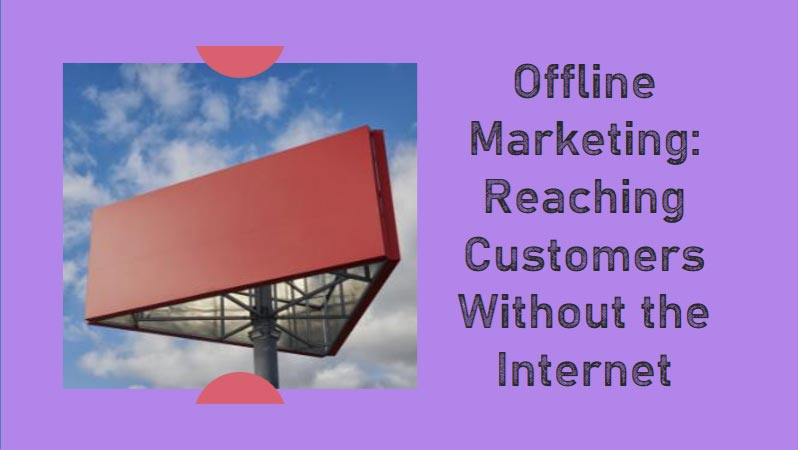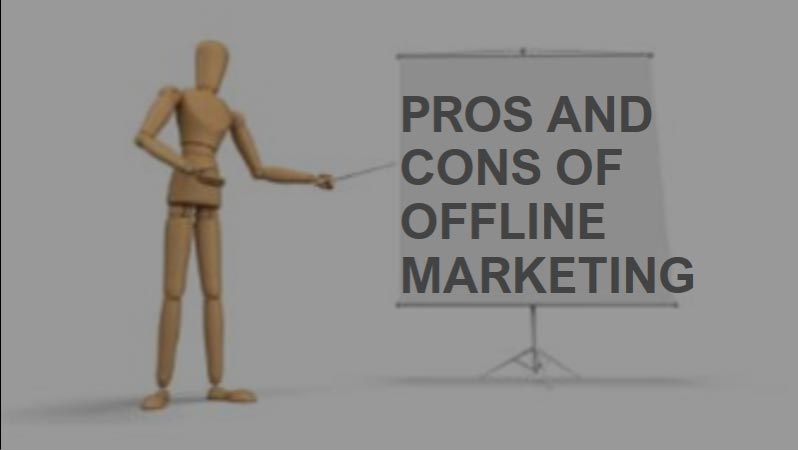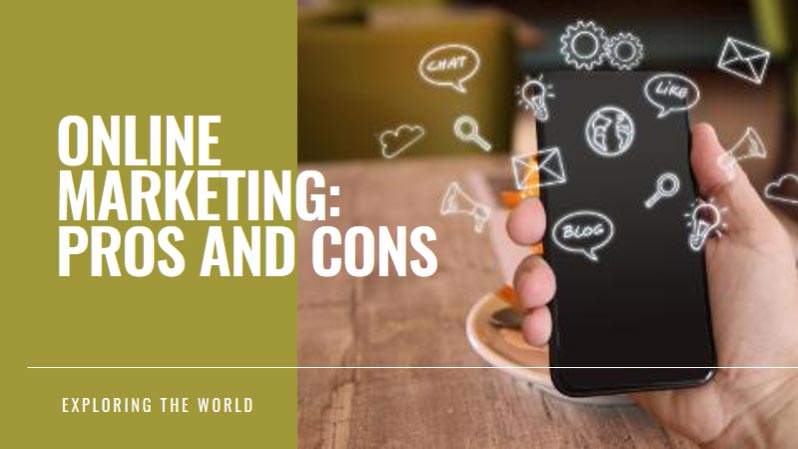Want to explore ideas and promote your business through offline marketing, you have come to the right place.
Today, business has made a lot of progress. People are now competing with each other in their businesses. One of the best ways to make progress is through marketing. It can help you succeed in any type of business, whether it’s online or offline.
With the right tactics and strategies, you can become superior in one way or another. There used to be a debate about whether social media marketing or email marketing is better. But that doesn’t matter. Even if you’re a business entrepreneur, you need to have official meetings to gain your investors’ trust in your service and products. This is where offline marketing comes in. You meet people and businesses and exchange ideas.
In this guide, we will share tips on how you can promote your business through offline marketing.
What is Offline Marketing?

Offline marketing refers to the traditional methods of promoting products or services that do not involve the use of the Internet. This type of marketing relies on offline channels to reach and engage with potential customers.
Some common examples of offline marketing include:
- Print Advertising: This includes newspapers, magazines, brochures, flyers, and other printed materials distributed through various channels.
- Broadcast Advertising: Television and radio advertisements are forms of offline marketing that reach a broad audience.
- Direct Mail: Sending physical promotional materials, such as postcards, catalogs, or letters, directly to a target audience’s postal address.
- Outdoor Advertising: Billboards, posters, banners, and other signage are placed in public spaces to capture the attention of passersby.
- Event Sponsorship: Supporting or participating in local events, trade shows, conferences, and community activities to promote a brand.
- Telemarketing: Engaging potential customers through phone calls to promote products or services.
- Public Relations: Building relationships with the media and managing a positive public image through press releases, events, and other non-digital means.
- Networking: Building connections with potential customers and business partners through in-person meetings, conferences, and other face-to-face interactions.
While online marketing has become increasingly prevalent in the digital age, many businesses still incorporate offline marketing strategies to create a well-rounded and comprehensive approach to reaching their target audience.
The effectiveness of offline marketing methods can vary depending on the nature of the business, the target audience, and the overall marketing strategy.
Unleashing the Power of Offline Marketing: A Comprehensive Guide to Promoting Your Business

In an era dominated by digital marketing, the significance of offline marketing strategies should not be overlooked. While online channels offer vast opportunities, offline marketing remains a potent force for businesses aiming to establish a comprehensive presence.
This article delves into the world of offline marketing, providing insights and actionable tips to help businesses effectively promote their products or services in the real world.
Define Your Target Audience
Understanding your target audience is the cornerstone of any successful marketing campaign. Before diving into offline strategies, define your ideal customer demographics, preferences, and behaviors. This knowledge will guide the development of compelling offline campaigns that resonate with your audience.
Craft a Strong Brand Identity
Offline marketing begins with a solid brand identity. Develop a memorable logo, choose consistent colors and fonts, and create a compelling tagline. A cohesive brand identity enhances brand recall, making it easier for potential customers to recognize and remember your business.
Business Collateral: Business Cards, Brochures, and Flyers
Printed materials such as business cards, brochures, and flyers are timeless tools for promoting your business offline. Ensure that these materials reflect your brand identity, and distribute them strategically at networking events, local businesses, and community bulletin boards.
Networking Events and Trade Shows
Participating in networking events and trade shows provides an excellent opportunity to connect with potential customers and industry professionals. Create an engaging booth or display, and use the opportunity to showcase your products or services firsthand. Collect contact information for follow-ups and build lasting relationships.
Direct Mail Marketing
Direct mail remains a viable offline marketing channel. Create targeted and personalized mailers to reach specific demographics. Include enticing offers, promotions, or discounts to encourage recipients to take action. Track the effectiveness of your direct mail campaigns to refine your approach over time.
Billboard Advertising and Outdoor Media
Strategic placement of billboard advertisements and outdoor media can significantly enhance your business visibility. Select high-traffic locations relevant to your target audience, and design eye-catching visuals with concise messaging. This form of advertising can create lasting impressions on passersby.
Local Sponsorships and Community Involvement
Supporting local events, sports teams, or community initiatives can foster a positive image for your business. Sponsorships and involvement in community activities create brand awareness and demonstrate a commitment to the local area, building trust with potential customers.
Vehicle Branding
Utilize your business vehicles as mobile advertising platforms. Apply your logo, contact information, and a brief message about your products or services to create moving billboards. This is a cost-effective way to increase brand visibility, especially if your business involves regular transportation.
Host Workshops and Seminars
Position your business as an industry expert by hosting workshops or seminars. Share valuable insights and knowledge related to your products or services. This not only establishes credibility but also provides an opportunity to connect with potential customers in a meaningful way.
Leverage Public Relations
Build relationships with local media outlets to secure coverage for your business. Press releases, feature stories, and interviews can generate positive publicity. Be proactive in sharing your business achievements, milestones, and community contributions to enhance your public image.
Overall, offline strategies play a pivotal role in building a well-rounded promotional campaign. By combining online and offline efforts, businesses can create a comprehensive marketing strategy that reaches a diverse audience.
Remember, the key lies in understanding your target audience, maintaining a consistent brand presence, and creatively utilizing various offline channels to connect with potential customers in the real world.
Exploring the Pros and Cons of Offline Marketing Strategies

In the rapidly evolving landscape of marketing, offline strategies continue to play a crucial role alongside their digital counterparts. Offline marketing, also known as traditional or traditional marketing, encompasses a variety of channels that do not rely on the Internet.
This includes print media, television and radio advertisements, direct mail, events, and more. As businesses strive to create comprehensive marketing campaigns, it’s essential to weigh the advantages and disadvantages of offline marketing to make informed decisions about resource allocation.
Advantages of Offline Marketing
Tangible Presence:
One of the primary advantages of offline marketing is the tangible presence it offers. Physical materials such as brochures, business cards, and posters create a tangible connection with the audience. This physical presence can enhance brand recall and leave a lasting impression.
Targeted Reach:
Offline marketing allows for targeted reach to specific demographics. Advertisers can choose television programs, radio slots, or publications that cater to their target audience. This targeted approach increases the likelihood of reaching potential customers who are more likely to be interested in the product or service.
Localized Impact:
For businesses with a local focus, offline marketing is highly effective. Local newspapers, community events, and regional television channels enable businesses to connect with the local community and build a strong, grassroots presence.
Established Credibility:
Traditional marketing channels, such as print ads in reputable magazines or newspapers, can lend credibility to a brand. Consumers often associate being featured in well-known publications with a level of trustworthiness and legitimacy.
Personalization Opportunities:
Offline marketing allows for personalized interactions. Events, trade shows, and direct mail campaigns provide opportunities for face-to-face engagement, enabling businesses to establish personal connections with their audience.
Disadvantages of Offline Marketing
Limited Analytics:
One of the significant drawbacks of offline marketing is the limited ability to track and analyze performance metrics. Unlike digital marketing, where precise data on audience engagement, conversion rates, and ROI are readily available, offline campaigns often rely on more indirect methods of measurement.
High Costs:
Traditional marketing methods can be expensive. Television and radio advertisements, print materials, and event sponsorships often require a significant budget. For small businesses or startups with limited resources, this can be a barrier to entry.
Limited Interactivity:
Offline marketing lacks the interactive features that digital platforms offer. Interaction is often one-way, making it challenging to engage customers in a dialogue or receive immediate feedback.
Less Flexibility:
Traditional marketing campaigns are often less flexible than digital ones. Once a print ad is published or a television commercial airs, it cannot be easily modified. This lack of flexibility can be a disadvantage in a fast-paced market where adaptability is crucial.
Global Reach Challenges:
While offline marketing is effective at a local level, reaching a global audience can be challenging. Digital platforms provide a more scalable and cost-effective solution for businesses looking to expand their reach beyond geographical boundaries.
In summary, the effectiveness of offline marketing strategies depends on various factors, including the nature of the business, target audience, and overall marketing goals. Combining offline and online strategies in a well-balanced marketing mix often yields the best results.
By carefully considering the advantages and disadvantages of offline marketing, businesses can make informed decisions to create comprehensive and effective marketing campaigns that resonate with their target audience.
Exploring the World of Online Marketing: Pros and Cons

In the digital age, online marketing has become an integral part of the business landscape, offering unprecedented opportunities for reaching a global audience. From social media campaigns to search engine optimization (SEO), businesses are leveraging various online channels to promote their products and services. However, like any strategy, online marketing comes with its own set of pros and cons.
Pros of Online Marketing:
Global Reach:
One of the most significant advantages of online marketing is the ability to reach a vast global audience. Through platforms like promotion on social media, businesses can connect with consumers from different corners of the world, expanding their market reach beyond geographical constraints.
Cost-Effectiveness:
Compared to traditional forms of marketing, online marketing is often more cost-effective. Digital channels, such as social media and email, allow businesses to target specific demographics with precision, reducing advertising costs and increasing the return on investment (ROI).
Measurable Analytics:
Online marketing provides businesses with the ability to track and measure the performance of their campaigns in real time. Email Marketing tools offer insights into website traffic, conversion rates, and customer behavior, enabling data-driven decision-making for continuous improvement.
Targeted Advertising:
Online marketing allows businesses to create highly targeted and personalized advertising campaigns. Through data analysis and user profiling, advertisers can tailor content to specific demographics, increasing the likelihood of reaching their ideal audience.
Interactivity and Engagement:
Online marketing fosters two-way communication between businesses and consumers. Social media platforms and interactive content enable engagement, feedback, and relationship-building, creating a more dynamic and personalized brand-consumer interaction.
Cons of Online Marketing:
Saturation and Competition:
As online marketing continues to grow, the digital landscape becomes increasingly saturated. This saturation can make it challenging for businesses, especially small ones, to stand out amid fierce competition, requiring strategic planning and innovative approaches.
Security and Privacy Concerns:
With the rise of online transactions and data collection, security and privacy concerns have become significant drawbacks. Consumers are more cautious about sharing personal information, and businesses must invest in robust cybersecurity measures to protect sensitive data.
Rapid Technological Changes:
The fast-paced evolution of technology presents a challenge for businesses to keep up with the latest trends and tools in online marketing. Adapting to new platforms and technologies requires ongoing education and investment, which may strain resources for some businesses.
Digital Fatigue:
Consumers are bombarded with a constant stream of online content, leading to digital fatigue. This oversaturation can result in consumers ignoring or blocking ads, making it difficult for businesses to capture and retain their audience’s attention.
Dependence on Third-Party Platforms:
Many businesses rely on third-party platforms, such as social media networks and search engines, for their online marketing efforts. Changes in algorithms or policies by these platforms can have a significant impact on a business’s visibility and success, creating a level of dependency that comes with inherent risks.
To summarize, online marketing has transformed the way businesses connect with their target audience, offering unprecedented opportunities for growth and engagement. However, businesses need to navigate the landscape carefully, considering both the advantages and disadvantages of online marketing.
Striking a balance between various strategies, staying informed about industry trends, and maintaining a focus on building meaningful relationships with consumers can help businesses thrive in the dynamic world of online marketing.
Conclusion
In conclusion, we have learned some ways to promote your business through offline marketing. Some small businesses do not have enough resources to spend millions on online marketing. Offline marketing is an old method of reaching customers.
Before online marketing, people used to meet each other and discuss their businesses, helping each other grow. As technology took over, offline marketing began to decline. However, there are still entrepreneurs who believe that face-to-face conversations are better for growing their businesses, even with technology.
Offline marketing allows you to attend meet-ups, seminars, and meetings to share ideas with potential investors.
Now over to you,
Do you prefer online marketing over offline marketing or vice versa?
How are you marketing your business online or offline?
Please let us know your thoughts and follow us on Facebook and Twitter.
